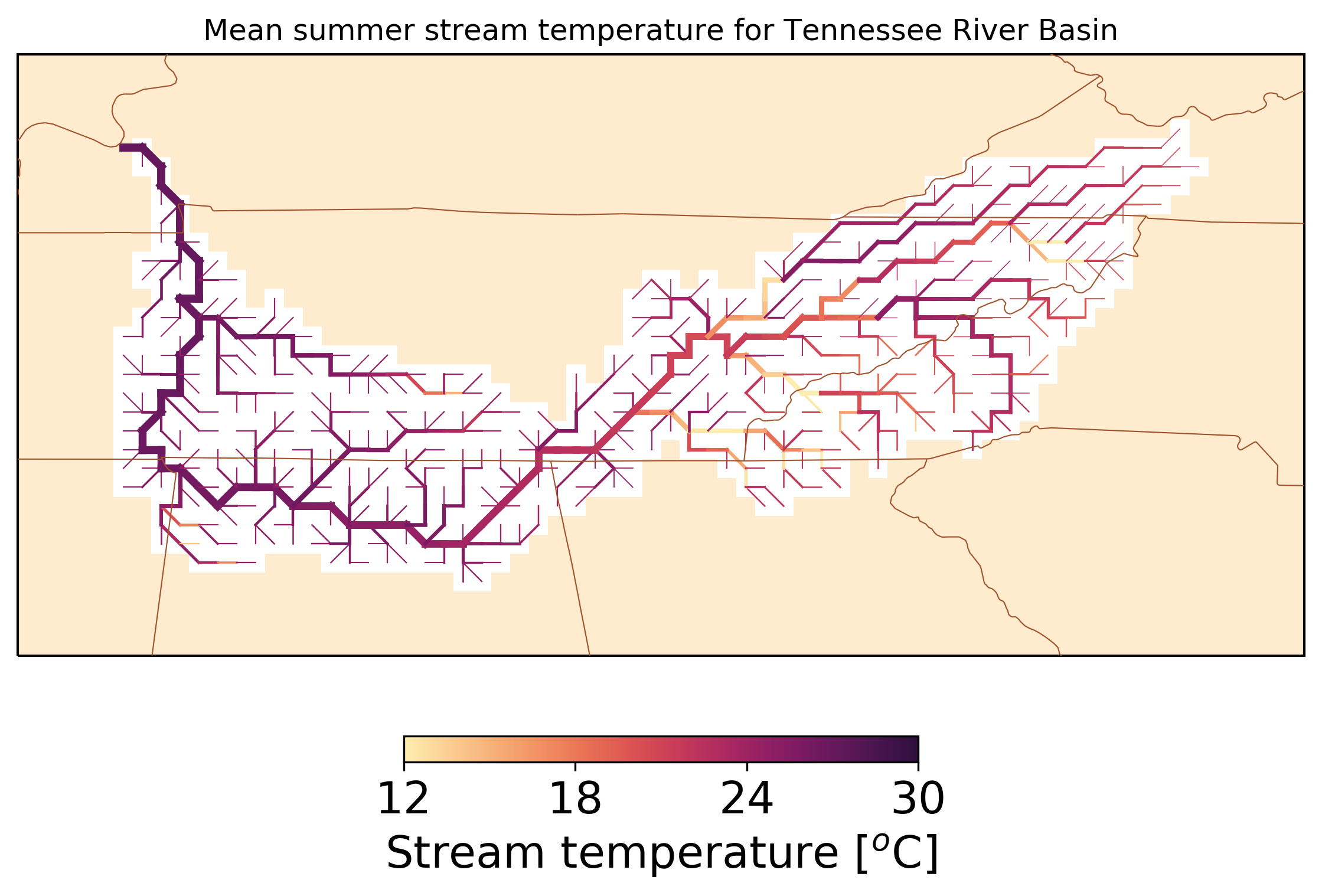Visualizing River Network#
%matplotlib inline
# =========== Load python modules =========== #
import numpy as np
import pandas as pd
import xarray as xr
import matplotlib.pyplot as plt
import matplotlib
import cmocean
from mpl_toolkits.axes_grid1 import make_axes_locatable
import cartopy.crs as ccrs
import cartopy.feature as cfeature
from cartopy.mpl.gridliner import LONGITUDE_FORMATTER, LATITUDE_FORMATTER
import cartopy.io.shapereader as shpreader
from cartopy.io.shapereader import Reader
from cartopy.feature import ShapelyFeature
from matplotlib import colors as c
from cartopy.io.srtm import srtm_composite
from mpl_toolkits.axes_grid1.inset_locator import inset_axes
#=================================# This script is used to plot a river network, showing river width through the width of line segment and another river-related variable, e.g., stream temperature, through the color of line segment.
Note: this script is design to plot for grid-based river network.
#===============define functions===============#
def find_downstream_grid_arcgis(flow_dir, lat_pre, lon_pre, delta):
'''
This function is used to find downstream grid cell based on the flow direction number of that grid cell.
Meanwhile, this is for Arc GIS format.
Input: 1) flow_dir: flow direction number
2) lat_pre: latitude for current grid cell
3) lon_pre: longitude for current grid cell
4) delta: grid cell size
output:
[lat_post, lon_post]
'''
if flow_dir in [1, 2, 128]:
lon_post = lon_pre + delta
else:
if flow_dir in [8, 16, 32]:
lon_post = lon_pre - delta
else:
lon_post = lon_pre
if flow_dir in [2, 4, 8]:
lat_post = lat_pre - delta
else:
if flow_dir in [32, 64, 128]:
lat_post = lat_pre + delta
else:
lat_post = lat_pre
if flow_dir == 0:
lat_post = lat_pre
lon_post = lon_pre
return [lat_post, lon_post]
def cal_width(flow):
'''
Calculate width based on flow
'''
if flow<=1:
width=0.1
else:
width=np.log10(flow)
return width
# ===============================================#
# read in required data #
# ===============================================#
# flow direction file in netCDF format
fdr_ds= xr.open_dataset('data/region6_fdr_udpate.nc')
# domain file in netCDF format
domain_ds = xr.open_dataset('data/domain.Tennessee.nc')
lat_domain_list=domain_ds.lat.values
lon_domain_list=domain_ds.lon.values
# resolution of grid
resolution = 1./8.
# mean annual streamflow in netCDF format
# Stream width is calculated based on streamflow
flow_mean = xr.open_dataset('data/mean_flow.nc')
# mean seasonal stream temperature in netCDF format
# river segment color is based on mean summer stream temperature
temp_mean = xr.open_dataset('data/mean_temp.nc')
temp_mean = temp_mean['T_stream']
# ===============================================#
# generate required format #
# ===============================================#
from_lon_list=[]
from_lat_list=[]
to_lon_list=[]
to_lat_list=[]
width_list=[]
temp_color_list=[]
# define the range of the colormap
vmax=30
vmin=12
norm = matplotlib.colors.Normalize(vmin=vmin, vmax=vmax)
for lat in lat_domain_list:
for lon in lon_domain_list:
# if this grid is within our domain
if domain_ds.mask.sel(lat=lat,lon=lon)==1:
# find the latitude and longitude of downstream grid cell
fdr=fdr_ds.flow_direction.sel(lat=lat,lon=lon)
lat_post,lon_post=find_downstream_grid_arcgis(fdr,lat,lon,resolution)
# find the streamflow
flow=float(flow_mean.streamflow.sel(lat=lat,lon=lon))
# calculate width based on streamflow
width=cal_width(flow)
# find the stream temperature
temp=float(temp_mean.sel(lat=lat,lon=lon,month=6))
# give color based on the stream temperature
color=cmocean.cm.matter(norm(temp))
# add to list
from_lon_list.append(lon)
from_lat_list.append(lat)
to_lon_list.append(lon_post)
to_lat_list.append(lat_post)
width_list.append(width)
temp_color_list.append(color)
# summarize it into a dataframe, which we will use it for plotting
plot_df=pd.DataFrame(np.transpose([from_lon_list,from_lat_list,
to_lon_list,to_lat_list,
width_list]),
columns=['from_lon','from_lat','to_lon','to_lat','width'])
plot_df['color']=temp_color_list
# ===============================================#
# Plotting #
# ===============================================#
fig = plt.figure(figsize=(15, 6), dpi=300)
ax = plt.subplot(111, projection=ccrs.PlateCarree())
# plotting backgroud
states_provinces = cfeature.NaturalEarthFeature(
category='cultural',
name='admin_1_states_provinces_lines',
scale='10m',
facecolor='none')
country_bound = cfeature.NaturalEarthFeature(
category='cultural',
name='admin_0_boundary_lines_land',
scale='10m',
facecolor='none')
coastline = cfeature.NaturalEarthFeature(
category='physical',
name='coastline',
scale='10m',
facecolor='none')
river = cfeature.NaturalEarthFeature(
category='physical',
name='rivers_lake_centerlines',
scale='10m',
facecolor='none')
ax.add_feature(states_provinces, edgecolor='sienna', linewidth=0.5, zorder = 5)
ax.add_feature(coastline, edgecolor='black', zorder = 5)
ax.add_feature(cfeature.LAND,color='blanchedalmond')
ax.add_feature(cfeature.OCEAN, color='skyblue')
ax.add_feature(cfeature.LAKES,color='skyblue')
ax.add_feature(country_bound, edgecolor='black', zorder = 5)
# define the color of the mapping background
cmap_bg = matplotlib.colors.LinearSegmentedColormap.from_list("", ["white"]*2)
# plot the domain
domain_ds.mask.plot.pcolormesh(add_colorbar=False, cmap=cmap_bg,vmax=2,vmin=0.95)
# plot the river network
for i in plot_df.index.values:
plt.plot([plot_df['from_lon'].loc[i], plot_df['to_lon'].loc[i]],
[plot_df['from_lat'].loc[i], plot_df['to_lat'].loc[i]],
lw=plot_df['width'].loc[i],c=plot_df['color'].loc[i],zorder=5)
# generate colorbar
pcm = temp_mean.sel(month=6).plot.pcolormesh(cmap=cmocean.cm.matter, add_colorbar=False,
vmax=vmax,vmin=vmin, zorder=0)
cb = fig.colorbar(pcm, ax=ax, pad=0.1,shrink=0.25,
ticks=[12, 18, 24, 30],orientation='horizontal')
cb.set_label('Stream temperature ['+r"$^o$"+'C]', fontsize=18)
cb.ax.tick_params(labelsize=18)
# add title
plt.title('Mean summer stream temperature for Tennessee River Basin')
Text(0.5, 1.0, 'Mean summer stream temperature for Tennessee River Basin')

